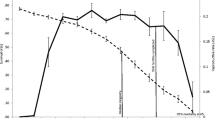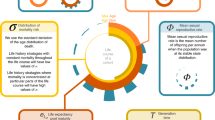Abstract
A large part of the diversity of longevity and actuarial senescence (i.e., the progressive decline of survival probabilities with age) across vertebrates can be related to body size, phylogeny, and the species’ position on the slow-fast continuum of life histories. However, differences in mortality patterns between ecologically similar species, such as bovids and equids, remain poorly understood. Equids are commonly understood to outlive bovid species relative to their body mass, despite very similar feeding niches. Comparing survival patterns of 13 bovid and ten equid sub-species, our findings confirm that equids outlive bovid species, with a higher adult survival rate and a delayed onset of senescence for equids, but no difference of rate of actuarial senescence. These differences are associated with a slower generation time and longer inter-birth interval, due to a longer gestation period, for equids compared to bovids. Finally, our results suggest that all biological times (i.e., all life history traits expressed in time units) have evolved synchronously in bovids, whereas in equids gestation time and inter-birth interval either were never in synchrony with, or have slowed down relative to other biological times. Our findings suggest the existence of different selection pressures, or different constraints, on specific time-related traits between these two mammalian families.


Similar content being viewed by others
References
Baur R (1977) Morphometry of the placental exchange area. Adv Anat Embryol Cell Biol 53:1–63
Bronikowski AM, Vleck D (2010) Metabolism, body size and life span: a case study in evolutionarily divergent populations of the garter snake (Thamnophis elegans). Integr Comp Biol 50:880–887
Buffenstein R (2008) Negligible senescence in the longest living rodent, the naked mole-rat: insights from a successfully aging species. J Comp Physiol B 178:439–445
Burnham KP, Anderson DR (2002) Model Selection and Multimodel Inference: A Practical Information-Theoretic Approach. Springer, New York
Choquet R, Rouan L, Pradel R (2009) Program E-SURGE: a software application for fitting multievent models. Environ Ecol Stat 3:8–39
Clauss M, Rössner GE (2014) Old World ruminant morphophysiology, life history, and fossil record: exploring key innovations of a diversification sequence. Ann Zool Fenn 51:80–94
Damuth J, Janis CM (2014) A comparison of observed molar wear rates in extant herbivorous mammals. Ann Zool Fenn 51:188–200
Dray S, Dufour AB (2007) The ade4 package: implementing the duality diagram for ecologists. J Stat Softw 22:1–20
Gaillard J-M, Delorme D, Boutin J-M, Van Laere G, Boisaubert B, Pradel R (1993) Roe deer survival patterns: a comparative analysis of contrasting populations. J Anim Ecol 62:778–791
Gaillard J-M, Duncan P, van Wieren SE, Loison A, Klein F, Maillard D (2008) Managing large herbivores in theory and practice: is the game the same for browsing and grazing species? In: Gordon IJ, Prins HHT (eds) The Ecology of Browsing and Grazing. Springer, Berlin, Heidelberg, pp 293–307
Gaillard J-M, Lemaître J-F, Berger V, Bonenfant C, Devillard S, Douhard M, Gamelon M, Plard F, Lebreton J-D (2016) Life history axes of variation. In: Kliman RM (ed) The Encyclopedia of Evolutionary Biology. Elsevier, Oxford, pp 312–323
Gaillard J-M, Pontier D, Allaine D, Lebreton J-D, Trouvilliez J, Clobert J (1989) An analysis of demographic tactics in birds and mammals. Oikos 56:59–76
Gaillard J-M, Viallefont A, Loison A, Festa-Bianchet M (2004) Assessing senescence patterns in populations of large mammals. Anim Biodivers Conserv 27:47–58
Gaillard J-M, Yoccoz NG, Lebreton J-D, Bonenfant C, Devillard S, Loison A, Pontier D, Allaine D (2005) Generation time: a reliable metric to measure life-history variation among mammalian populations. Am Nat 166:119–123
Gamelon M, Focardi S, Gaillard J-M, Gimenez O, Bonenfant C, Franzetti B, Choquet R, Ronchi F, Baubet E, Lemaître J-F (2014) Do age-specific survival patterns of wild boar fit current evolutionary theories of senescence? Evolution 68:3636–3643
Gorbunova V, Seluanov A, Zhang Z, Gladyshev VN, Vijg J (2014) Comparative genetics of longevity and cancer: insights from long-lived rodents. Nat Rev Genet 15:531–540
Gordon IJ, Prins HHT (eds) (2008) The Ecology of Browsing and Grazing. Ecological Studies. Springer-Verlag, Berlin, Heidelberg
Grange S, Duncan P (2006) Bottom-up and top-down processes in African ungulate communities: resources and predation acting on the relative abundance of zebra and grazing bovids. Ecography 29:899–907
Grange S, Duncan P, Gaillard J-M, Sinclair ARE, Gogan PJP, Packer C, Hofer H, East M (2004) What limits the Serengeti zebra population? Oecologia 140:523–532
Hammers M, Richardson DS, Burke T, Komdeur J (2013) The impact of reproductive investment and early-life environmental conditions on senescence: support for the disposable soma hypothesis. J Evol Biol 26:1999–2007
Hatt J-M, Codron D, Müller DWH, Ackermans NL, Martin LF, Kircher PR, Hummal J, Clauss M (2019) The rumen washes off abrasives before heavy-duty chewing in ruminants. Mammal Biol 97:104–111
Healy K, Guillerme T, Finlay S, Kane A, Kelly SBA, McClean D, Kelly DJ, Donohue I, Jackson AL, Cooper N (2014) Ecology and mode-of-life explain lifespan variation in birds and mammals. Proc R Soc B Biol Sci 281:20140298
Hofmann RR (1989) Evolutionary steps of ecophysiological adaptation and diversification of ruminants: a comparative view of their digestive system. Oecologia 78:443–457
Janis C (1976) The evolutionary strategy of the Equidae and the origins of rumen and cecal digestion. Evolution 30:757–774
Jones OR, Gaillard J-M, Tuljapurkar S, Alho JS, Armitage KB, Becker PH, Bize P, Brommer J, Charmantier A, Charpentier M, Clutton-Brock T, Dobson FS, Festa-Bianchet M, Gustafsson L, Jensen H, Jones CG, Lillandt B-G, McCleery R, Merilä J, Neuhaus P, Nicoll MAC, Norris K, Oli MK, Pemberton J, Pietiäinen H, Ringsby TH, Roulin A, Saether B-E, Setchell JM, Sheldon BC, Thompson PM, Weimerskirch H, Jean Wickings E, Coulson T (2008) Senescence rates are determined by ranking on the fast-slow life-history continuum. Ecol Lett 11:664–673
Jones OR, Scheuerlein A, Salguero-Gómez R, Camarda CG, Schaible R, Casper BB, Dahlgren JP, Ehrlén J, García MB, Menges ES, Quintana-Ascencio PF, Caswell H, Baudisch A, Vaupel JW (2014) Diversity of ageing across the tree of life. Nature 505:169–173
King SJ, Arrigo-Nelson SJ, Pochron ST, Semprebon GM, Godfrey LR, Wright PC, Jernvall J (2005) Dental senescence in a long-lived primate links infant survival to rainfall. Proc Natl Acad Sci USA 102:16579–16583
Lemaître J-F, Gaillard J-M, Bingaman Lackey L, Clauss M, Müller DWH (2013) Comparing free-ranging and captive populations reveals intra-specific variation in aging rates in large herbivores. Exp Gerontol 48:162–167
Lemaître J-F, Müller DWH, Clauss M (2014) A test of the metabolic theory of ecology with two longevity data sets reveals no common cause of scaling in biological times: longevity scaling in mammals. Mammal Rev 44:204–214
Melis C, Nilsen EB, Panzacchi M, Linnell JDC, Odden J (2013) Roe deer face competing risks between predators along a gradient in abundance. Ecosphere 4:art111
Moorad JA, Promislow DEL, Flesness N, Miller RA (2012) A comparative assessment of univariate longevity measures using zoological animal records. Aging Cell 11:940–948
Morrison DF (1967) Multivariate Statistical Methods. McGraw-Hill, New York
Müller DWH, Bingaman Lackey L, Streich WJ, Fickel J, Hatt J-M, Clauss M (2011) Mating system, feeding type and ex situ conservation effort determine life expectancy in captive ruminants. Proc R Soc B Biol Sci 278:2076–2080
Müller DWH, Bingaman Lackey L, Streich WJ, Hatt J-M, Clauss M (2010) Relevance of management and feeding regimens on life expectancy in captive deer. Am J Vet Res 71:275–280
Nussey DH, Froy H, Lemaître J-F, Gaillard J-M, Austad SN (2013) Senescence in natural populations of animals: widespread evidence and its implications for bio-gerontology. Ageing Res Rev 12:214–225
Pérez-Barberia FJ, Gordon IJ (1998) The influence of molar occlusal surface area on the assimilation efficiency, chewing behaviour and diet selection of red deer. J Zool 245:307–316
Péron G, Gimenez O, Charmantier A, Gaillard J-M, Crochet P-A (2010) Age at the onset of senescence in birds and mammals is predicted by early-life performance. Proc R Soc B Biol Sci 277:2849–2856
R Development Core Team (2016) A language and environment for statistical computing. R Foundation for Statistical Computing, Vienna
Ricklefs RE (1998) Evolutionary theories of aging: confirmation of a fundamental prediction, with implications for the genetic basis and evolution of life span. Am Nat 152:24–44
Ricklefs RE (2010) Life-history connections to rates of aging in terrestrial vertebrates. Proc Natl Acad Sci USA 107:10314–10319
Rose KD (1996) On the origin of the order Artiodactyla. Proc Natl Acad Sci USA 93:1705–1709
Ruby JG, Smith M, Buffenstein R (2018) Naked mole-rat mortality rates defy Gompertzian laws by not increasing with age. eLife 7
Schulz E, Kaiser TM (2013) Historical distribution, habitat requirements and feeding ecology of the genus Equus (Perissodactyla). Mammal Rev 43:111–123
Skogland T (1988) Tooth wear by food limitation and its life history consequences in wild reindeer. Oikos 51:238–242
Staerk J, Conde DA, Ronget V, Lemaître J-F, Gaillard J-M, Colchero F (2019) Performance of generation time approxiamtions for extinction risk assessments. J App Ecol 56:1436–1446
Stearns SC (1983) The influence of size and phylogeny on patterns of covariation among life-history traits in the mammals. Oikos 41:173–187
Tacutu R, Craig T, Budovsky A, Wuttke D, Lehmann G, Taranukha D, Costa J, Fraifeld VE, de Magalhães JP (2012) Human Ageing Genomic Resources: integrated databases and tools for the biology and genetics of ageing. Nucleic Acids Res 41:D1027–D1033
Tidière M, Gaillard J-M, Müller DWH, Bingaman Lackey L, Gimenez O, Clauss M, Lemaître J-F (2015) Does sexual selection shape sex differences in longevity and senescence patterns across vertebrates? A review and new insights from captive ruminants. Evolution 69:3123–3140
Veiberg V, Mysterud A, Gaillard J-M, Delorme D, Laere GV, Klein F (2007) Bigger teeth for longer life? Longevity and molar height in two roe deer populations. Biol Lett 3:268–270
Vermeij GJ (1994) The evolutionary interaction among species: selection, escalation, and coevolution. Annu Rev Ecol Syst 25:219–236
Wich SA, Shumaker RW, Perkins L, de Vries H (2009) Captive and wild orangutan (Pongo sp.) survivorship: a comparison and the influence of management. Am J Primatol 71:680–686
Zerbe P, Clauss M, Codron D, Bingaman Lackey L, Rensch E, Streich JW, Hatt J-M, Müller DWH (2012) Reproductive seasonality in captive wild ruminants: implications for biogeographical adaptation, photoperiodic control, and life history. Biol Rev 87:965–990
Acknowledgments
We are very grateful to the many people who generously provided data on live weights and on the animals’ life histories so that we could carry out the analyses with confidence, in particular Kristin Brabender (Hortobagy National Park, Hungary), Frédéric Joly (previously with Takh, France), Jim Kao (Taipei Zoo), Klaus Mueller-Schilling (Hannover Zoo), Peter Novellie (Nelson Mandela Metropolitan University, South Africa), Kate Schoenecker (US Geological Survey, USA), Juan Soy (Al Wabra Wildlife Preservation, Qatar), Beatrice Steck (Basel Zoo, Switzerland), Tim Thier and Martha Fischer (St. Louis Zoo, USA), and Tim Woodfine, Tanya Langenhorst and Danielle Free (Marwell Wildlife, UK) who provided data on liveweights, and/or on the animals’ life histories; and Patricia Moehlman and Sarah King (IUCN Equid Specialist Group), Jan Robovsky (Liberec Zoo and University of South Bohemia, Czechia), Ulrike Rademacher (Stuttgart Zoo, Germany), Belinda Low Mackey (Grevy’s Zebra Trust, USA) and Laurent Tatin (Conservatoire des Espaces Naturels, Provence-Alpes-Côte d’Azur, France) who kindly linked us to sources of knowledge. We are grateful to one anonymous referee for helpful comments on a previous draft. Finally, we dedicate this paper to Colin Groves, posthumously, for his great contribution to our knowledge of equids.
Author information
Authors and Affiliations
Corresponding author
Electronic Supplementary Material
ESM 1
(DOCX 303 kb)
Rights and permissions
About this article
Cite this article
Tidière, M., Duncan, P., Lemaître, JF. et al. Do Equids Live longer than Grazing Bovids?. J Mammal Evol 27, 809–816 (2020). https://doi.org/10.1007/s10914-019-09483-8
Published:
Issue Date:
DOI: https://doi.org/10.1007/s10914-019-09483-8




